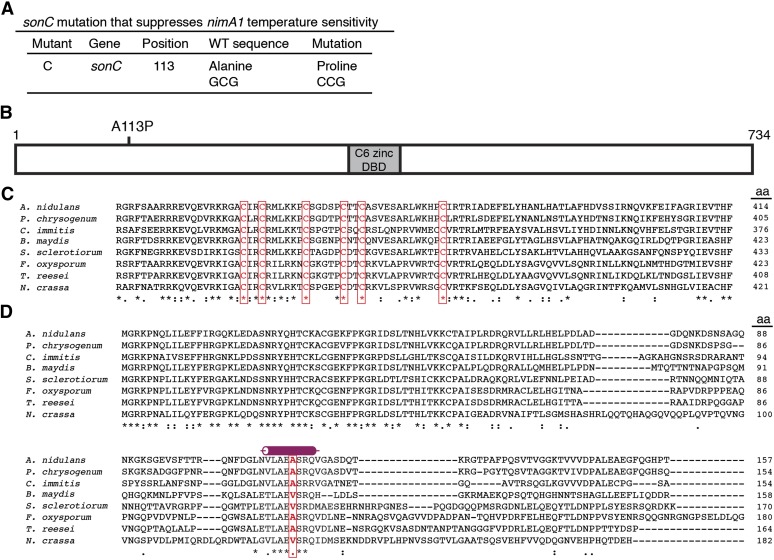Figure 5.
Mutant C contains a mutation in the locus designated as AN1232 and representing the sonC gene, which defines a protein containing a Zn2Cys6 domain. (A) Table showing the mutation found in mutant C. (B) Diagram of SonC, which contains a C6 zinc finger potential DNA-binding domain (gray box), and the mutation found in mutant C (sonC1), which is located in the N-terminal region. (C) ClustalW alignment (http://workbench.sdsc.edu) of SonC and its orthologs. Identical groups [indicated by an asterisk (*)], conserved strong groups [indicated by a colon (:)], and conserved weak groups [indicated by a period (.)] are noted. Accession numbers for the sequences are the following: A. nidulans (AN1232; Aspergillus Genome Database, http://www.aspgd.org); Penicillium chrysogenum (Pc16g03990); Coccidioides immitis (CIMG_10322); Bipolaris maydis (COCC4DRAFT_161203, with amino acids 642–689 removed prior to performing the alignment as this region is absent from the other orthologs and so is likely part of an intron); Sclerotinia sclerotiorum (SS1G_09964); Fusarium oxysporum (FOXB_15136, with amino acids 1–67 removed prior to performing the alignment as this region is likely part of the 5′ UTR); Trichoderma reesei (hypothetical protein, locus EGR51802); and Neurospora crassa (NCU07692). The C6 zinc finger domain is highly conserved, and the six cysteine residues with the spacing CX2CX6CX5CX2CX12C are found in all SonC orthologs (boxed in red). (D) SonC orthologs were found only in the Ascomycota, and the amino acid changed in sonC1 (boxed in red) occurs in a short, highly conserved region of the protein predicted to form an alpha-helix (JPred 3) (Cole et al. 2008). Sequences used are the same as in C. See Figure S2 for the alignment of the entire protein sequences.

